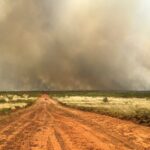The Syrian civil war has been going on for more than twelve years. During this time, the population has suffered greatly from violence and oppression by warring factions, as well as economic hardship and disease due to the gradual deterioration of the economy and essential services. In parts of Syria, especially in the Turkish and rebel-held northwest, ongoing violence continues to regularly kill civilians. In the Kurdish-controlled northeast, the security situation had been relatively stable for several years, but Deir ez-Zor was recently wracked by violence as Arab tribes revolted against the Kurdish-led Syrian Democratic Forces (SDF); elsewhere in the region, the widespread destruction caused by years of conflict is still being felt. The rest of the country, controlled by President Bashar al-Assad’s government forces, is not doing much better. The economy is in free fall and anti-government protests are spreading again in the south.
The United Nations estimates that Syrians in every sub-region of the country are currently experiencing humanitarian stress for the first time since the start of the conflict. By 2022, 15 million of Syria’s population of 22 million were in need of humanitarian assistance and 12 million people were considered food insecure, especially in the opposition-held north. These numbers have only increased as a result of the earthquake that struck Syria and Turkey in February 2023, killing thousands of people and displacing tens of thousands more in northwestern Syria. The humanitarian situation has been further exacerbated by the failure of the UN Security Council to reach a consensus in July on expanding cross-border aid to the northwest through the Bab al-Hawa border crossing, and a subsequent agreement with the Syrian government has resulted in a sharp conflict. decline in assistance. As Syria’s humanitarian, political and economic challenges occur simultaneously with increasingly hot and dry summers, conflict and climate-related factors have worsened, resulting in the emergence of a so-called ‘triple water crisis’.
Back to back droughts
Syria’s triple water crisis reflects three crises that focus on the reliability of water supplies across the country. The first crisis centers on the successive droughts that have hit the region over the past three summers, with up to 60% less rainfall. The last time such regular droughts occurred was in the years leading up to the outbreak of civil war in 2011. Since 2021, Syria has again suffered record high temperatures, causing widespread forest fires and droughts. In the context of a crumbling economy and a lack of government support, the impact on Syria’s heavily agriculturally driven economy has been devastating. Food insecurity had already increased dramatically since the start of the conflict. Before 2011, Syria was self-sufficient in wheat production, with an annual growth of 4.1 million tons. But during the fighting, large areas of land have been burned or destroyed, rendering the fields unusable. The broader economic crisis caused by the war has left many farmers unable to feed their livestock or invest in their crops. Today, Syrian wheat production stands at 2.2 million tons per year, making the country a net importer. This situation has been particularly striking in northeastern Syria, which has traditionally been considered the country’s breadbasket and main source of wheat production.
Decreasing flow on the Euphrates
The second crisis is the sharp drop in the water level of the Euphrates River. This river, which originates in Turkey and flows through Syria and Iraq to the Persian Gulf, and its tributaries represents the main water source for more than 5 million people throughout Syria. But the flow of the Euphrates has reached dangerously low levels for three summers in a row. Most of the water comes from the Armenian highlands, where years of rainfall deficits are causing a long-term reduction in river flow. Reduced precipitation and warmer climate conditions are expected to lead to a 23.5% decrease in river discharge by the end of the century compared to the 2000s.
Another factor linked to the third consecutive year of reduced river discharge is political. Turkey has been accused of restricting the flow of water at its border with Syria since 2021 – affecting the access of both Syria and Iraq. Syria and Turkey have a 1987 water-sharing agreement that guarantees Syria an average of 500 million cubic meters of water per second, but the amount of water coming from Turkey has fallen to less than 300 million cubic meters per second since January 2021 . This time frame coincided with the onset of droughts and with Turkey’s attempts to contain Kurdish forces in northern Syria, making it likely that water is at least partially withheld for tactical reasons. Turkey has denied any responsibility for the severe reduction in river flows, pointing to the droughts the country has experienced itself.
The impact of water shortages on agriculture, livestock and food security has two important consequences. Firstly, the shortage has implications for wider public services, as some of the most important hydroelectric dams along the Euphrates are close to “dead level” – the minimum water level to produce electricity, with huge consequences for the already faltering electricity production in Syria. Second, water quantity problems lead to water quality problems. As the Euphrates transports less water, the concentration of harmful pollutants in the water increases, and consequently the incidence of water-borne and water-related diseases. This deteriorated water quality is one of the main causes of the recent resurgence and spread of diseases in Syria, such as the ongoing cholera epidemic that broke out in September 2022.
Drinking water crisis
The third element in the triple water crisis is largely related to the conflict: the malfunctioning of the Alouk Water Station, located in northeastern Syria, near the Turkish border, and on which half a million people depend as their primary source of drinking water. In October 2019, the Turkish Armed Forces and the Syrian National Army launched a military offensive, Operation Peace Spring, creating a 30-kilometer buffer zone against the SDF along the Syrian-Turkish border. Alouk Water Station is now part of this buffer zone. Since 2020, Alouk has been regularly out of service, with disastrous consequences for the access to drinking water of people in the region. The Kurds blame the Turks and say they are deliberately withholding water from the Kurdish-run region. The Turks point to technical malfunctions as a result of the electricity crisis that hinder the proper functioning of Alouk. Lack of transparency and supervision makes it difficult to determine the true causes. What is certain, however, is that the issue is highly politicized and contributes to the conflict dynamics, and the entire northeastern region of Syria has not been able to rely on Alouk for three years. Since people no longer have their main water source, they have turned to alternatives, mainly boreholes. But this has led to an alarming over-extraction of groundwater and the lowering of water levels in the aquifers, which had already been declining in recent decades. In addition, there are serious concerns about the quality of the water in these boreholes and the associated health risks from drinking it.
Outlook
The triple water crisis in Syria shows that in conflict situations the environment itself becomes political. By contributing to the depletion of the Euphrates and other water sources, droughts are exacerbating the already dire situation of millions of Syrians across the country. Water is not a standalone resource; it is linked to food security, economic security, health and the continuity of crucial public services. As a vital resource, water is also an attractive target for control, influence and competitive advantage during conflict. The Alouk Water Station crisis would not have been so devastating for the people of northeastern Syria if they had had sufficient, viable alternatives.
When the environment becomes a factor of conflict, its protection is no longer a priority. Years of war have left their mark on Syria’s ecosystems, as water supplies and fields have been contaminated by landmines and explosive remnants of war, and natural habitats in conflict zones have been destroyed. Syria has lost 20% of its forest cover since the start of the conflict, with drought-induced forest fires causing further reductions in recent years. The climate-related causes of the triple water crisis will not go away in the coming years as Syria becomes drier and hotter. The only way forward in this crisis requires a political willingness to reprioritize the well-being of people and the environment, but so far the results of this are not promising.
Megan Ferrando is a non-resident scientist at the Middle East Institute’s Climate and Water Program. She is currently based in Jordan and supports the work of the humanitarian NGO Solidarités International.
Photo by DELIL SOULEIMAN/AFP via Getty Images
The Middle East Institute (MEI) is an independent, non-partisan, non-profit educational organization. It does not engage in advocacy and the opinions of its scholars are their own. MEI welcomes financial donations, but retains exclusive editorial control over its work and its publications reflect only the opinions of the authors. For a list of MEI donors, click here.


